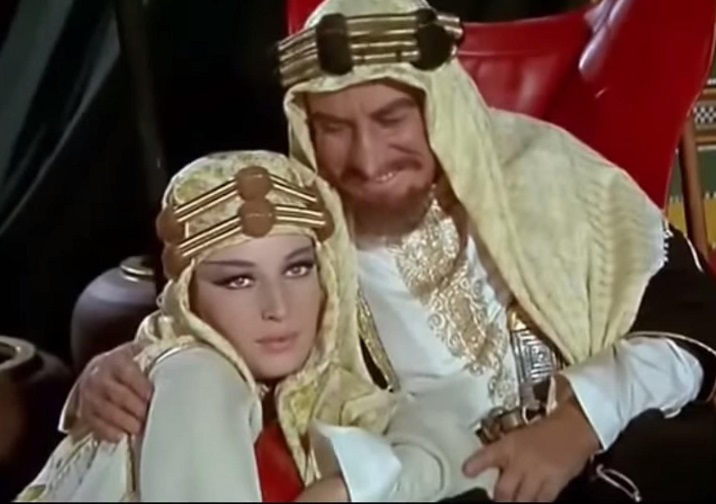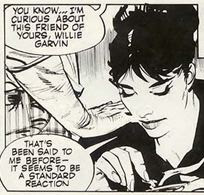I am a huge fan of Modesty Blaise. The cheap description of the character is “the female James Bond,” but oh, Modesty is so much more than that. She was born in 1963, when writer Peter O’Donnell and illustrator Jim Holdaway brought to British newspaper strip comics—and later novels—her adventures in subterfuge and action and capers that took her all across the world. She is one of my favourite sex positive comic icons, and, in a discussion about female comic characters and sexuality, I cited Modesty as an example of someone who is inherently sexual, but whose sexuality is used sparingly, in context, and with far greater subtlety than we tend to see today.
Apparently, I was convincing enough for Claire to decide to check out some Modesty herself. Only, I thought that meant she’d start reading the comics or books. Oh no. Claire went and found that 1966 groovy, campy movie version starring Monica Vitti and Terence Stamp. The one I refuse to watch because you can’t be turning this:

Into this:
couples’ robes!! I’m in heaven pic.twitter.com/1H8hFVz8Aw
— Claire (@illusClaire) March 7, 2015

Okay, granted, when I read the Modesty Blaise novels, they featured gloriously 1980s-ified covers like the one on the right. (Is … is that a pube?) The 80s also brought us a Modesty Blaise pilot that, despite reasonably good response, did not become a television series. I’ve seen this. It was okay, by ’80s standards, and I completely approve of the scene with Modesty’s butler Weng answering the door with a hangover and ordering the guests to shut the door behind them.
But it’s the comics and novels that I’ve always loved, and, even with the patent leather clad cover designs, the stories within are always about the elegant and deadly Modesty and her loyal sidekick Willie Garvin.
Claire could have at least tried My Name is Modesty, a film for which Quentin Tarantino sponsored the release. My Name is Modesty is a prequel of sorts, and it follows her rise to power within the crime syndicate known as The Network. Like me, Tarantino is a long time fan of the character. I squealed in the theatre when I saw John Travolta reading a Modesty Blaise graphic novel in Pulp Fiction, but aside from this moment and his support for My Name is Modesty, Tarantino has failed to give me the Modesty Blaise movie I deserve (although, honestly, I’d prefer if he didn’t actually direct it…).
In the mean time, I’m stuck with this:

Normally, I am not a purist, and am all for interesting re-imaginings of characters, but Modesty is one of my idols. You can’t just add psychedelics and make a mockery of her! And worse, I’ve read the Wikipedia entry! Not only are there musical numbers, but this movie ruins the most perfect platonic relationship between Willie and Modesty by making them lovers. Already I am stabbed in the heart a thousand times over, but Claire swears that this film starring Monica Vitti and Terence Stamp is great and that I really should watch it.
Claire: Okay, first of all, I’m never going to go to something with “Tarantino” written on it first. I’ll save my poison tongue for now, but: let that stand.

I. loved. Modesty Blaise (1966). From two distinct angles: one, it was perfectly graphic, in that marvelous “translate psychedelia for the squares with the cash” 1960s technicolor way. The sets, the clothes, oh my goodness. I ate it up. Everyone, everything, was aesthetically defined, exaggerated, often familiar, but made strange and glorious. Naturally there are comparisons to Bond films to be made. Most of them will be boring, but here are mine: the accountant’s final stand felt like it could have birthed the entirety of 1967 Casino Royale. Casino Royale, initial version, is a gradually degenerating spoof of Bond before Bond was anywhere near the bloated corpse it became. (Speaking of this film inspiring things—did some real spy murders happen in Doll Central, Amsterdam, or did Alistair MacLean perhaps enjoy this film too? Puppet on a Chain, 1969…)
My favourite Bond film is Octopussy, and my favourite part of Octopussy is the pre-credits sequence. Identical twin knife-throwers in boots and little waistcoats chase a desperate clown through the woods. He tries to cross a river, is killed (or is he), and washes up in a city. Struggling through the streets, past security, the damp clown crashes through the conservatory window of an Embassy, shocking the guests (a glamorous party is in full flow) and dying. His final act is to drop a (fake!) faberge egg. Oh my word, that sequence is fantastic. Modesty Blaise has the same pomp and serious absurdity, but it has it throughout. I was so joyful! Wendy, don’t be a hater!!

The second way that I liked it so much was that it wasn’t cruel. The script was written by Evan Jones, an Afro-Caribbean man who graduated from Oxford in 1952 and forged a successful and ongoing career in writing (here’s a piece about one of his poems). And the film was directed by Joseph Losey—an ex-Hollywooder who was blacklisted for communism. Both of these men would have already known very well what it felt like to be told “people like you can’t have these things we value.” In my opinion, this shines through. I was already quite giddy about how there was no shame, no spite, no belittlement in any of the characters or set pieces before I looked up the creators.
Two examples: when the mime walks past the row of men at work in their “available for rendezvous” sex booths. These men are not made absurd; the unfamiliarity of men taking the role of sex worker that a British middle-classer probably feels, sure, that’s used, but the joke rather feels like it’s on you, the audience, for being sooo awfully unhip as to think “good heavens!” Second, the villain is dontsaygay, as villains often are. But he’s not disgusting, he doesn’t die, he retains dignity throughout, and he’s very likeable. He’s played by Dirk Bogarde, who was gay in the game and gay for real, which probably helps. And the “feminine sensitivity” which dontsaygayness affords a written man is used to enhance the audience’s emotional engagement with the events of the film. As a viewer who cannot stand watching the Rebel Fighters die one by one before Luke destroys the Deathstar, I very much appreciated a character addressing the tragedy of the cannon-fodder mook. That he was responsible for the deaths he was mourning made it better, frankly, a little sharper. It’s more interesting to have a villain who knows he’s a murderer.
Two women die; one death is sad and one is ridiculous. The former allows Modesty to display tenderness, generosity, and warmth; the latter is so rambunctious that it’s impossible to feel the feminine template suffers. The day is saved, at the very last minute of the film by muslims! And not just characters who happen to be muslims; this is a faction defined entirely by their Middle-Eastern, Islamic identity. So their making the big save … in turn, defines “Muslim” as “heroic.” Piss on every other British action spy film!
It also has a number of very good jokes.
As for your dislike of Modesty and Willie becoming lovers—they don’t. They make an enormous point of how they aren’t, in fact. They SING A SONG about how they could have been lovers, but never have, and aren’t. Sure, they decide that maybe they should, and eventually agree that they will, but! The final scenes have them separate, Willie getting a sexy milk bath from a number of women, Modesty snuggling with her dad. They don’t actually ~go there~ in the end. They both take various lovers throughout, and all the singing seems like an early ship wars joke, tbh …

“She is the shadow on your bedroom wall. She is the dream you never found.”
 But I won’t be wooed so easily by a movie that features mimes and more costume changes than Queen Amidala in The Phantom Menace. Modesty also gets herself caught often and quite easily and has to call upon Willie Garvin to rescue her. Modesty is no damsel in distress, dammit! In fact, she was the one who rescued Willie, an almost feral criminal pit fighter when she found him. Now he is her most loyal sidekick. Their perfectly platonic relationship is often questioned in the comics and books, though the couple politely defer. It hurt my heart to think that the movie threw this beautiful relationship under the bus.
But I won’t be wooed so easily by a movie that features mimes and more costume changes than Queen Amidala in The Phantom Menace. Modesty also gets herself caught often and quite easily and has to call upon Willie Garvin to rescue her. Modesty is no damsel in distress, dammit! In fact, she was the one who rescued Willie, an almost feral criminal pit fighter when she found him. Now he is her most loyal sidekick. Their perfectly platonic relationship is often questioned in the comics and books, though the couple politely defer. It hurt my heart to think that the movie threw this beautiful relationship under the bus.
But Claire is right. This movie is a spoof and this was one of the many things the writers (not including O’Donnell himself, who apparently hated all but the Tarantino film) satirized. The film is about having fun with the characters and the story, but not making fun on them—a subtle form of humour that is all but lost in comedy movie-making these days.

While I’m not fond of Modesty having to call Willie for a save, Vitti and Stamp did manage to capture all the little things that make their relationship so good. The silent communication, the way they are always there for each other, and have always got each other’s back when the shit hits the fan.
Even with the modifications to suit the spoof format, the movie doesn’t lose some of the serious aspects of Modesty’s character. Aside from the silliness, the story adheres very closely to the first Modesty Blaise book. It introduces Gerald Tarrant of British Intelligence, who tries to coerce Modesty into doing what British Intelligence can’t do: stop Gabriel from pulling off the biggest diamond heist in history. In the movie, Tarrant has all sorts of tricks up his sleeve, or rather, his umbrella, but it is evident from early on that Modesty is no fool. Just who is playing whom, you wonder, especially when Tarrant introduces her to Sheik Abu Tahir—only to find that the man affectionately calls Modesty his son. Imagine a Hollywood film where Muslim people are not cast as terrorists, but as allies who even come in to save the heroes.

The Modesty Blaise stories I know are far more serious than she is presented here, but Modesty herself is not without a sense of humour that includes that all important ability to laugh at herself. She’s also a woman who can adapt to both her environment and the times, and she has never been one to judge. So, while I am perturbed by the psychedelic walls and blond wigs, Claire’s assessment of the deeper meaning behind the film’s creation and the very positive elements makes my superficiality glaringly obvious.

